This City in Western New York Has Become an Unexpected Cultural Destination — Thanks to a Brand-new Attraction
- Oops!Something went wrong.Please try again later.
- Oops!Something went wrong.Please try again later.
The expanded Buffalo AKG Art Museum bolsters an already stellar presence of historic institutions and significant sites in New York state's Queen City.
A nuanced term in the Finnish language that lacks a direct English translation might not seem like the most obvious descriptor for a city in the northeastern U.S. Yet Janne Sirén sees a connection. The word sisu "means a combination of determination, grit, and courage — but not bullyish. More of a quiet determination," explains Sirén, the director of the Buffalo AKG Art Museum, who is from Finland. "I think there's a lot of grit and genuineness in the Buffalo mix," he adds. "Buffalo has some of that grit in its DNA, maybe because the city has also seen such hard times since World War II."
But let's not say Buffalo is having a comeback. Niagara Falls never ceased its roaring churn. The Queen City's elegant network of Frederick Law Olmsted and Calvert Vaux–designed parkways, created a decade after the duo began shaping Central Park, have remained intact, as has much of the built environment that bloomed in the prosperous wake of the Erie Canal's opening in 1825. From that point on, Buffalo enjoyed a decades-long boom that continued through the early 20th century, albeit with unequal access to the benefits. Then, a shrinking population and other structural headwinds took a toll, as did heartbreaking current events.
And while urban revival comeback narratives can be overly simplified and reductive, the signs of Buffalo's next chapter are unmistakably vibrant. Take the 2020 Census population figures, for instance, which revealed an increase of 17,500 residents in the City of Buffalo. "We were all shocked in the city planning department," says Chris Hawley, an urban planner, historic preservation advocate, and all-around Buffalo champion about the very welcome surprise. Hawley points to historically robust immigrant and newer refugee communities as being largely responsible for this development. The Downtown Bazaar, a small business and food entrepreneur incubator run by the Westminster Economic Development Initiative, is one of the ways local organizations are harnessing this strength that's essential to the future of Rust Belt towns.
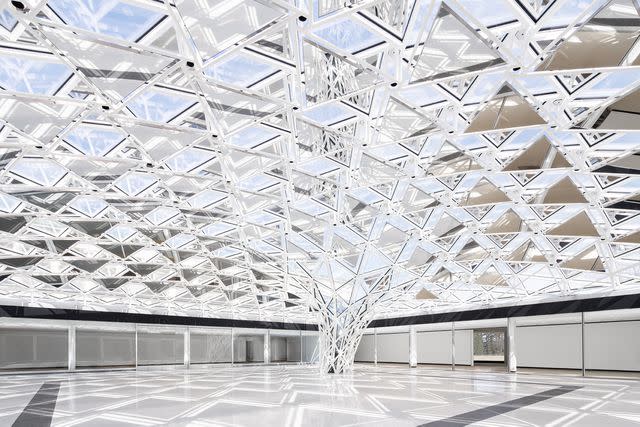
Courtesy of Buffalo AKG Art Museum
The reopening of the aforementioned Buffalo AKG Art Museum, formerly known as the Albright-Knox Art Gallery, is the splashiest news this year. With an illustrious past — its 1862 founding places it as the sixth oldest museum in the country — architect E.B. Green's beaux-arts-style cultural palace has stood since 1905. It's a jewel in the crown of Olmsted and Vaux's idyllic Delaware Park. Locals and art lovers have long appreciated the otherwise under-the-radar collection's choice pieces. The AKG's reimagined complex presents compelling aesthetic juxtapositions — as any worthwhile museum building project should — and a community-welcoming ethos. The Jeffrey E. Gundlach Building designed by OMA and principal Shohei Shigematsu, with its glowing glass and alluring interiors, is the most buzzy component. But the project entailed far more than shining a starchitect-wattage spotlight; it's a $230-million undertaking that's the largest investment of its kind in western New York state.
Since construction began in November 2019, the AKG curatorial team combed through and re-contextualized selections. Contemporary works representing an ever-widening range of voices get a much-deserved venue in the Gundlach Building's enticing 30,000 square feet. Notable, too, is the inaugural exhibition of Clyfford Still's monumental abstract expressionist paintings, as seen in the ground-level galleries. The update of the 1905 Robert and Elisabeth Wilmers Building allows treasures that span periods and styles, from "The Marina Piccola, Capri" by Albert Bierstadt to Frida Kahlo's 1938 "Self Portrait with Monkey" and Jackson Pollock's "Convergence," to feel freshly imbued with relevance and dignity. These changes are campus-wide; the surface parking lot, which was an unfortunate yet understandable response to growing automobile-centrism, has been replaced with a reconstructed public-facing staircase facing Elmwood Avenue and landscaping that makes for a strengthened pedestrian experience. Shigematsu's sinuous and reflective John J. Albright Bridge conjoins the Gundlach and Wilmers Buildings, forging a physical and symbolic link. (The Gundlach Building properly opened on July 20 following the final stretch of construction.)

Courtesy of Buffalo AKG Art Museum
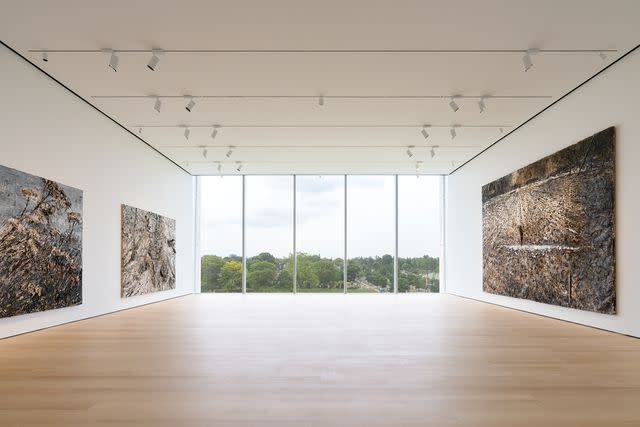
Courtesy of Buffalo AKG Art Museum
Gordon Bunshaft's striking modernist Seymour H. Knox Building retains its rational, crisp lines dating from 1962, and its serene steel and glass-encased auditorium surrounded by mature trees. Gone are the less functional elements, like the sunken sculpture garden — hardly practical during Buffalo's notoriously unkind winters — which instead houses the Ralph C. Wilson Jr. Town Square and "Common Sky." The latter refers to Olafur Eliasson and Sebastian Behmann of Studio Other Spaces' social media-friendly (but not gimmicky) architectural intervention-cum-art installation. Here, visitors access Cornelia, where "Chorus of the Deep," a site-specific commissioned mosaic by artist Firelei Báez, embellishes the casual restaurant. What were less than ideal settings for displaying art in the Knox have been configured into hands-on, inclusive art education spaces, including the Creative Commons workshop operated in collaboration with the LEGO Foundation.
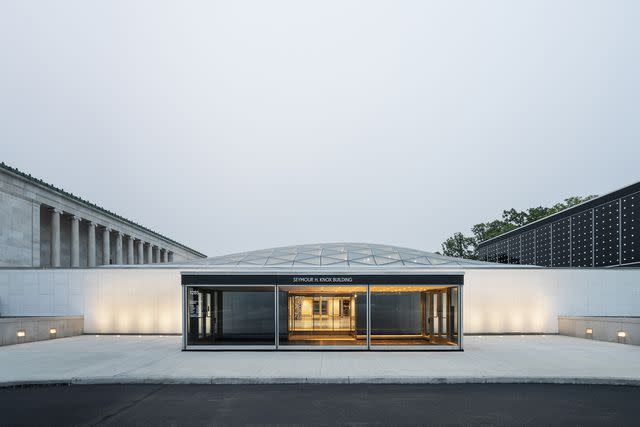
Courtesy of Buffalo AKG Art Museum
"When you are a little bit outside of a center, you actually have more creative freedom," Sirén observes. "You often have more genuine relationships with your community." Examples in Buffalo abound. The AKG shares its ambition and sense of shared purpose with other organizations and cultural assets. The Buffalo History Museum across Route 198 is an extant connection to the city's 1901 Pan-American Exposition. Directly opposite Elmwood Avenue stands the Burchfield Penney Art Center, established by artist Charles Burchfield to draw attention to artists from the region. Frank Lloyd Wright's Darwin Martin House located west of Delaware Park and built between 1903 and 1905 is among the best examples of the architect's signature Prairie style homes, the result of multiple painstaking restoration and reconstruction projects. It's one of several Wright houses in Buffalo, along with Graycliff, the Martin family's summer estate on Lake Erie situated 20-some miles south of the city.
Among the other seminal figures in American architecture whose commissions brought them to Buffalo — McKim, Mead & White, Louis Sullivan, and Minoru Yamasaki, to name a few — were the Finnish designers Eliel and Eero Saarinen. The father and son masters' Kleinhans Music Hall has exuded a heady, idiosyncratic amalgamation of warm modernism combined with precision acoustics since its completion in 1940. Buffalo is no exception to the rule that American cities and music are intertwined. (Buffalonian Rick James' gravesite is noted on Google Maps.) The Colored Musicians Club and Jazz Museum curates a must-visit portal into the intersections of music, race, and organized labor in Buffalo. Babeville at the Asbury Delaware Methodist Church operates as a unique performance hall thanks to the tireless efforts of music business entrepreneur Scot Fisher and musician Ani DiFranco. This 19th-century Gothic Revival building downtown is also home to the cutting edge Hallwalls Contemporary Arts Center.
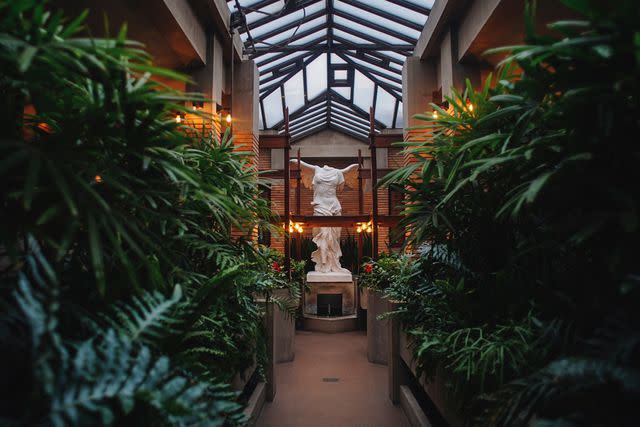
Libby March for The Washington Post/Getty Images
A visit arguably isn't complete without a pilgrimage to those towering temples of 19th century innovation and industry: the grain elevators. Given the truly massive scale of the structures, a select few of which remain in use (General Mills still produces Cheerios in Buffalo), adaptive reuse is a formidable challenge. Against this backdrop, Silo City complex is more proof of Buffalonians' resourcefulness. Just Buffalo Literary Center has organized the Silo City Reading Series for a decade, offering a powerful venue to hear spoken-word performances. Locals and visitors who appreciate the particular majesty of this scenery can eat and drink together at Duende. Soon mixed-use apartments and creative office space will bring more around-the-clock energy and an ongoing vested interest in environmental recovery. (Explore Buffalo and Buffalo River History Tours also bring visitors to Silo City and the revitalized waterfront that illustrate the history of the Erie Canal.)
To Buffalo native and artist Edreys Wajed, who runs the multidisciplinary consultancy and digital platform Eat Off Art with his wife, Alexa, the city's arts and cultural heritage is a beacon and a balm. "You have no control over athletic events, besides being there to celebrate and cheer," he says, slyly referencing the angst that's familiar to Buffalo Bills fans. Wajed is also among the local artists whose work has been showcased by the Buffalo AKG's Public Art Initiative and the Silo City Reading Series. "But I know that taking our children to the Albright-Knox and across the street to the Burchfield will lead to the person they're going to become," Wajed says.
Through ups and downs, this type of firm resolve and commitment to place — call it sisu, even — is a path forward for a proud city and its people.

Eric Frick/Courtesy of Visit Buffalo Niagara
Where to Eat and Drink
Whether or not people consciously know the geographic origins, chances are they're familiar with a certain culinary export. The mainstream omnipresence of Buffalo hot wings again proves New York state has an impressive number of locale-specific foods. Getting closest to the 1964 origin story means hitting the Anchor Bar's Main Street location, although posthumous recognition is finally being given to chef and restaurateur John Young. Duff's multiple outposts make this when-in-Rome food pilgrimage relatively convenient. Gabriel's Gate in lively Allentown is another reliable wings source.
Billy Club in Allentown and the Dapper Goose in Black Rock give their respective spins on New American cuisine in convivial dining rooms, with excellent cocktail programs and an emphasis on seasonality. Inizio in charming Elmwood Village attentively cranks out house-made pastas with an Italian wine list and amaro selection to boot, while Daniela is another neighborhood favorite spot for modern Italian that specializes in pinsa, a pan-baked pizza. Head to Mother's for comfort classics like the monster meatloaf and martinis.
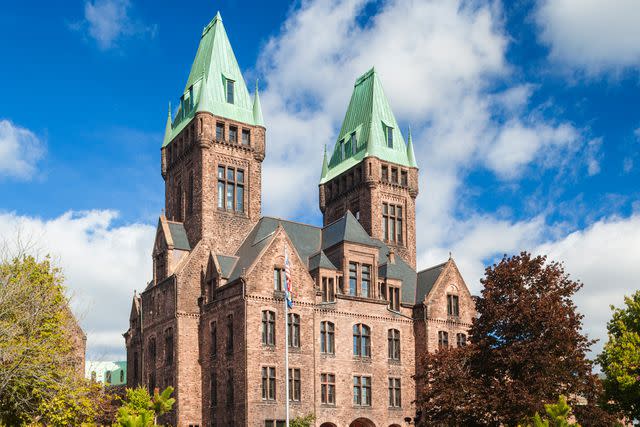
Walter Bibikow/Getty Images
Where to Stay
The Richardson Hotel set within the Richardson Olmsted Campus near the AKG can claim the most dramatic adaptive reuse journey of all. Few (if any) properties have evolved from a psychiatric hospital founded in the 1870s to an independently operated 88-room hotel. A recent renovation and rebrand has yielded some upgrades within the hulking, richly ornamented sandstone landmark by game-changing architect Henry Hobson Richardson; other wings of the building still sit vacant, awaiting their next chapter. For those who want to be downtown and within walking or biking distance of the KeyBank Center arena, Buffalo Theatre District, and other attractions, Hotel at the Lafayette and the Curtiss Hotel are ideally central.
For more Travel & Leisure news, make sure to sign up for our newsletter!
Read the original article on Travel & Leisure.

